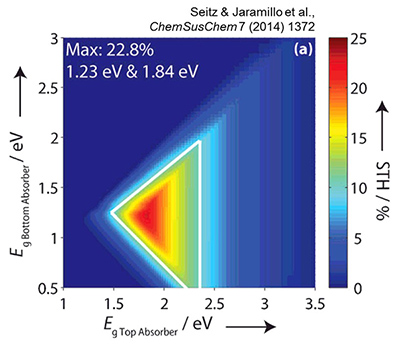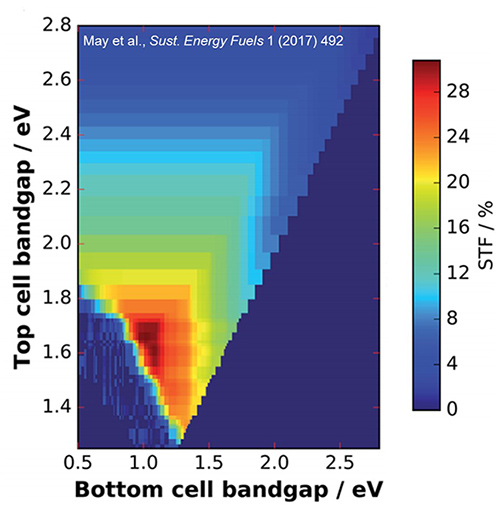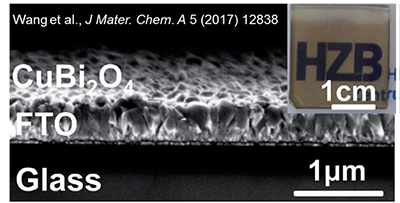Institute Solar Fuels
Light absorbers
Introduction
A central component of a solar fuel device is the light absorber: a semiconductor capable of generating charge carriers (i.e., electrons and holes) upon sunlight illumination. One of the most important requirements is therefore the bandgap of the semiconductors, which defines the part of the solar spectrum that can be absorbed. Typically, similar to solar cells, combining two (or more) semiconductors with varying bandgaps allows more efficient use of the solar spectrum. Numerous analyses have been done; all of which reported that a combination of a 1.6-1.8 eV large-bandgap semiconductor with a 1.1-1.3 eV small-bandgap semiconductor is the optimum, potentially capable of producing larger than 20% efficiency. These semiconductors would ideally of course be low-cost and stable in aqueous solutions. While several small-bandgap semiconductors are already available (e.g., Si, WSe2), a good large-bandgap semiconductor is still not clear.
Our approach
At the Institute for Solar Fuels, we focus on discovering novel large-bandgap semiconductors based on complex metal oxides, including (oxy)nitrides and (oxy)sulfides. Although this class of materials is typically not considered to be the best semiconductors, they are generally inexpensive (as compared to III-Vs) and much more stable in aqueous environments. Our efforts in the development of novel light absorbers can be divided into: (i) development of thin film synthesis procedure of high-performing complex metal oxides, (ii) rigorous analysis of the key optoelectronic properties that limit the photoelectrochemical performance, and (iii) integration of these novel absorbers into working solar fuel device. Numerous complex metal oxides have been investigated in our institute, such as metal tungstates (e.g., WO3, Fe2WO6), tantalum (oxy)nitrides, complex cuprates (CuBi2O4, CuFeO2) and metal vanadates (e.g., BiVO4, FeVO4).
Recent highlights
- We developed a simple spray-pyrolysis recipe resulting in highest-performing CuBi2O4 Essential to the high photocurrent is the control of additives in the precursor solution.
Wang, A. Chemseddine, F. F. Abdi, R. van de Krol, S. P. Berglund, Spray Pyrolysis of CuBi2O4Photocathodes: Improved Solution Chemistry for Highly Homogeneous Thin Films, Journal of Materials Chemistry A, 5, 2017, 12838-12847
- We published a couple of reviews on the material developments of semiconductor photoelectrodes.
Sivula, R. van de Krol, Semiconducting Materials for Photoelectrochemical Energy Conversion, Nature Reviews Materials, 1, 2016, 15010
F. Abdi, S. P. Berglund, Recent Developments in Complex Metal Oxide Photoelectrodes, Journal of Physics D: Applied Physics, 50, 2017, 193002
- The presence of hole polaron is BiVO4 is for the first time detected with time-resolved Terahertz conductivity (TRTC) measurements. We can finally offer greater understanding of the fate of photogenerated charge carriers in BiVO4.
Ziwritsch, S. Muller, H. Hempel, T. Unold, F. F. Abdi, R. van de Krol, D. Friedrich, R. Eichberger, Direct Time-Resolved Observation of Carrier Trapping and Polaron Conductivity in BiVO4, ACS Energy Letters, 1, 2016, 888-894





